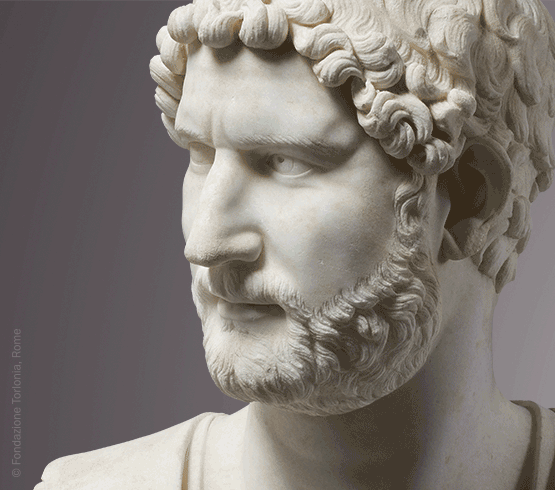The Dallas Museum of Art marks the spot for a jeweled treasure trove most Texans and even Dallas art lovers likely never knew was there all along. For 75 years, the DMA has received unique gifts of contemporary jewelry, while also quietly acquiring and commissioning work so that they’ve now amassed one of the largest and most comprehensive collections of its kind in the United States. With the opening of Constellations: Contemporary Jewelry at the Dallas Museum of Art, Nov. 9-May 3, 2026, the world can finally peek inside this jewelry box of a collection.
“This was an opportunity to bring them all together and really show people the depth and breadth of this collection. I don’t think people know the extent of what we have,” Schleuning later adding, “It’s really exciting for us because this is kind of the debut, the big announcement and showcasing of this incredible, world-class collection.”
When organizing such a multitude of pieces created by artists around the globe and formed from such a diversity of material, Schleuning says she thought of the stars, how we see them connected in the night sky and create stories around their placement in the heavens, hence the exhibition’s title.
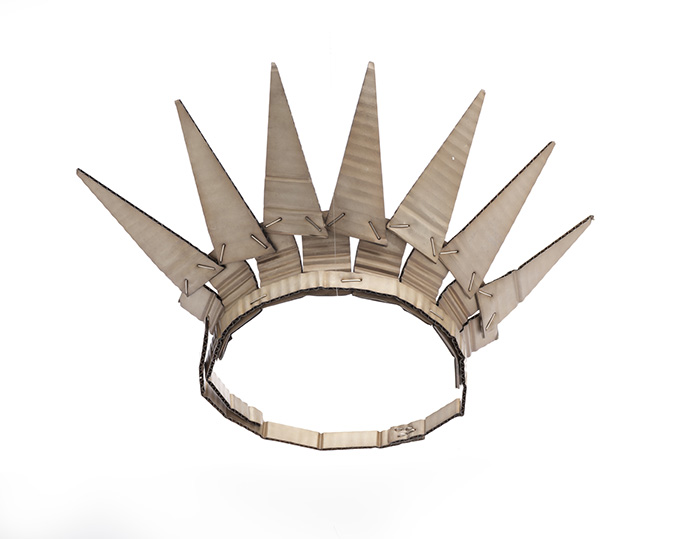
1 ⁄7
David Bielander, The Big Apple Neckpiece tiara and necklace, 2015, from the series Cardboard, patinated silver and white gold, Dallas Museum of Art, promised gift of Deedie Potter Rose. © David Bielander. Photo by Chad Redmon, courtesy Dallas Museum of Art.
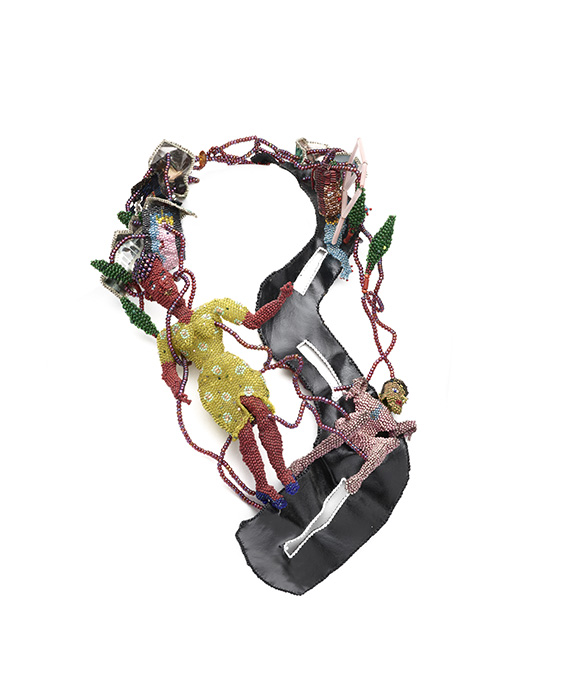
2 ⁄7
Joyce J. Scott, Run Down on the Highway of Love necklace, 1986, glass beads, leather, plastic, wire and photographs, Dallas Museum of Art, Discretionary Decorative Arts Fund, 2022.61. © Joyce J. Scott / Courtesy Goya Contemporary and Mobilia Galleries. Photo by Chad Redmon, courtesy Dallas Museum of Art.
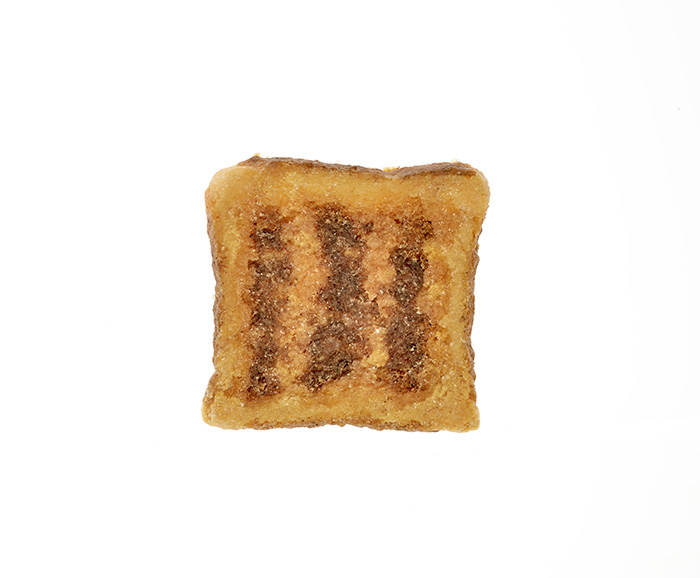
3 ⁄7
Gisbert Stach, Golden Toast #6 brooch, 2019, Baltic amber, silicone, and stainless steel, Dallas Museum of Art, promised gift of Deedie Potter Rose. © Gisbert Stach. Photo by Chad Redmon, courtesy Dallas Museum of Art.
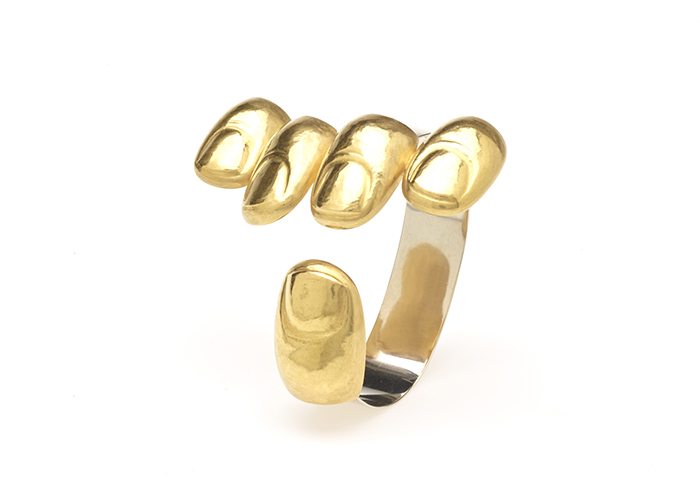
4 ⁄7
Bruno Martinazzi, Goldfinger bracelet, 1969, editioned: no. 9 of 12, 18k white gold and 20k yellow gold, Dallas Museum of Art, gift of Edward W. and Deedie Potter Rose, formerly Inge Asenbaum collection, Galerie am Graben in Vienna, 2014.33.353. © Bruno Martinazzi. Photo by Chad Redmon, courtesy Dallas Museum of Art.
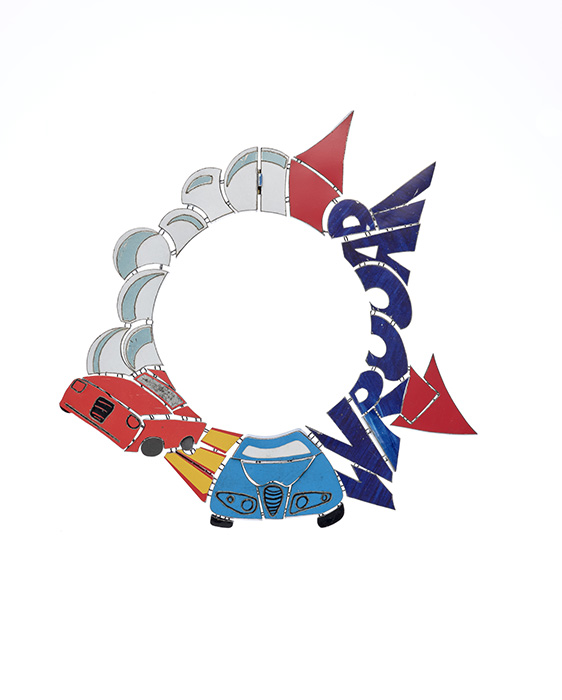
5 ⁄7
Monica Cecchi, Wrooar necklace, 2017, tin and silver, Dallas Museum of Art, promised gift of Deedie Potter Rose. © Monica Cecchi. Photo by Chad Redmon, courtesy Dallas Museum of Art.
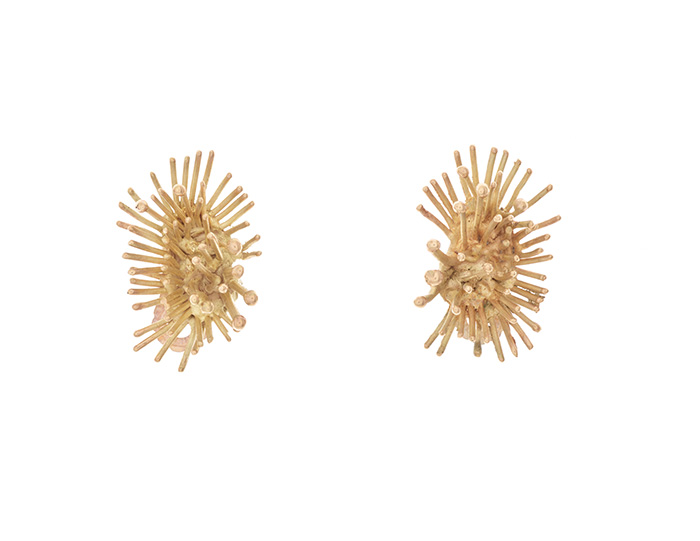
6/7
Velma Davis Dozier, Burr ear clips, 1958, gold, Dallas Museum of Art, Neiman-Marcus Purchase Prize, 10th Annual Texas Crafts Exhibition, 1958, 1958.56.A-B. © John Howard Washburn, Jr, Davis Madeleine Washburn Griffin, and Robert Miegel Jr. Photo by Chad Redmon, courtesy Dallas Museum of Art.
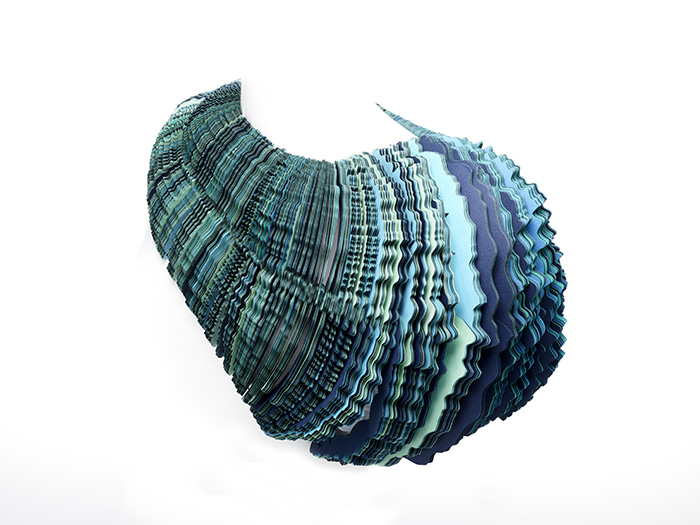
7 ⁄7
Genevieve Howard, Gleo neckpiece, 2023, Japanese linen paper, Fabriano paper, and elastic cord, Dallas Museum of Art promised gift of Deedie Potter Rose. © Genevieve Howard. Photo by Chad Redmon, courtesy Dallas Museum of Art.
“I was thinking about these as little constellations of ideas, but also about how you create your own constellations when you put jewelry on yourself. As you adorn yourself, you create your own things,” she described, but she also hopes DMA guests will see how these works might relate to each other when viewed together. “What I really wanted with the show was for people to create their own narratives, their own constellations of connections between objects.”
To do this, Schleuning, organized the exhibition thematically, though she says the show will highlight some of the different periods and movements of contemporary jewelry making. As these are works of art, and like more traditional types of contemporary art, they have the ability to challenge the viewer, evoking emotional and intellectual responses, Schleuning wanted to begin with a theme that would ground viewers a bit before going off into the conceptional. And so the exhibition begins with “Zones of the Body,” exploring how one unique aspect of jewelry as an art form is its wearability.
This section will examine how artists see these pieces of art aligning onto the body from head (tiaras and earrings), core (necklaces, brooches, and pins), and limbs (bracelets and rings).
“But of course, these are imagined in incredibly different ways,” says Schleuning, giving the example of David Bielander’s The Big Apple Neckpiece, a tiara and necklace that resembles the Statue of Liberty’s crown as if made of stapled cardboard, but on closer examination, is a crown made of real silver and gold.
The nature of the relationship between the artist and wearer can depend on the artist.
From “Zones,” we launch into the Constellation “Archetypes,” the fundamental shapes of creation, whether a brooch formed from electrical wire circled into colorful patterns or spheres that look like smashed olives.
“The idea was to look at geometries and some very foundational forms. So circles, triangles, squares, and all the different ways and interpretations artists make with them.”
From the body and geometry, the exhibition moves into “Signals” the meanings and concepts the artists weave into the work, taking the pieces beyond aesthetic pleasure for the wearer and viewer.
“This is how these become signifiers of bigger ideas,” explains Schleuning of this thematic section, using the example of a Joyce J. Scott necklace of wire, beads, and photographs depicting female figures on a stretch of asphalt. Titled Rundown on the Highway of Love, Schleuning says, “You would wear it on your neck and know I’m wearing discarded women on the highway.”
The final star system in Constellations comes back to the beginning in some ways, focusing on the “Play” and imagination inherent in many of these artworks. In these galleries we’ll see pieces like Gisbert Stach’s Golden Toast broaches. Made of amber resin, the brooches depict the entire toast spectrum from delicious light gold to charred black.
Wandering through this star field of jewelry, viewers can never doubt them as works of art and treasured components of the DMA’s collection.
“This is artwork. There’s an artist. There’s an intent. There’s incredible technical prowess, not only thought and ideation, but in the process of making.”
And now for the first time Lone Star art lovers have a chance to view the DMA’s wearable art collection shining united as a constellation.
“A lot of disparate and different thought processes are going into the creations of these works,” says Schleuning. “And so they range. The idea is to see interconnections and how those ideas work together or what you see in them. I thought it was just an incredible opportunity to do something like that and to make it really engaging and exciting for the public.”
—TARRA GAINES



